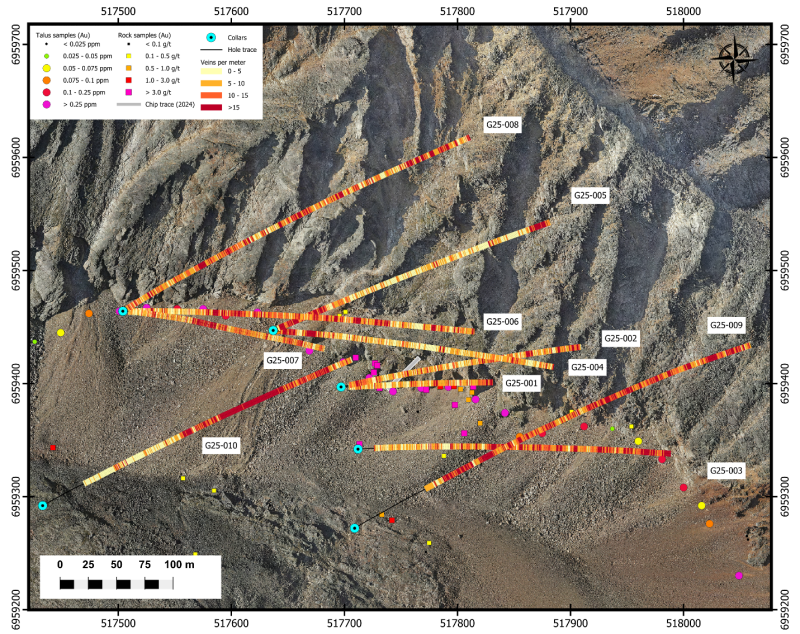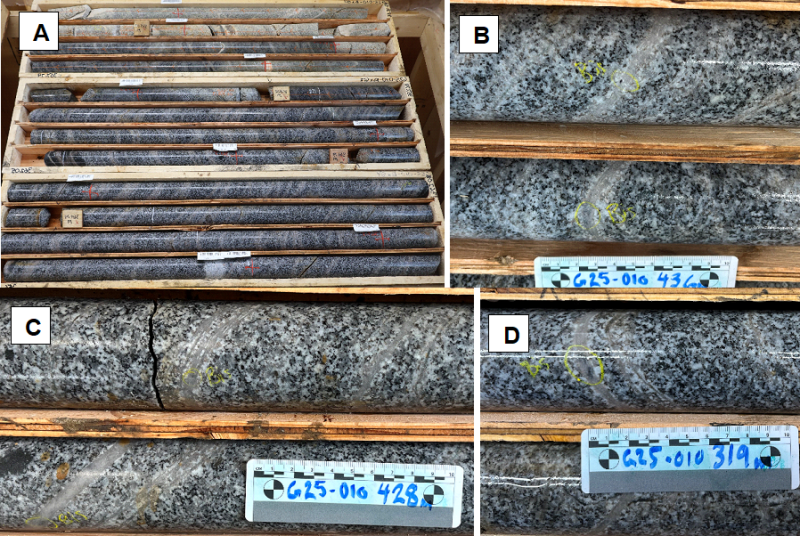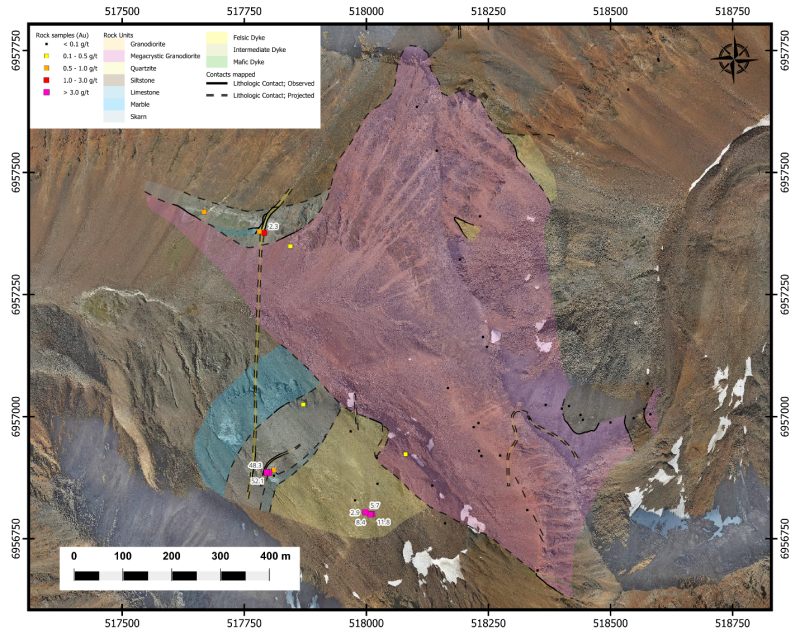(via TheNewswire)
Vancouver, British Columbia – TheNewswire - September 8, 2025 – Rackla Metals Inc. (TSX-V: RAK) (the “Company”) is pleased to announce that the Company has completed the 2025 drill program at the BiTe showing on the Grad Property. Additionally, the Company reports that it has made a new discovery from surface sampling on the Manta intrusion, 2 km south of the BiTe showing.
Rackla has also been informed by the lab that results from the first three drill holes will not be completed until after the 21 st of September.
The final two drill holes (G25-009 and 010) were drilled on the southern margin of the intrusion and encountered impressive alteration zones and abundant sheeted veining.
Sheeted veining and bismuth-sulphide/telluride(?) mineralization has been observed in all holes drilled in the program.
Core samples from all holes have been delivered to the lab and the Company still awaits the analytical results.
The first rock samples collected in the vicinity of the Manta intrusive have returned several multi-gram gold results associated with sheeted veining and bismuth mineralization.
The drill program at the BiTe showing was completed on September 4 and the drill crew has demobilized for the season. In 2025, 10 holes were completed for a total of 4,486 m. The drill program tested an area measuring 600 x 360 x 550 m.
The area tested has demonstrated a con sistent set of sheeted quartz/sulphide + tourmaline veins with 3 dominant vein orientations (Figure 1). A broad zone with intense quartz and quartz-tourmaline veining and elevated bismuth content was intersected at the top of holes G25-004 and 005. This zone has been intersected in holes G25-006, G25-007, G25-009 and G25-010. The zone shows good continuity and appears robust with increasing strength and width as the intercepts get deeper.
Sampling of quartz-arsenopyrite veins on the ridge top and high on the north face of the intrusive have returned low gold values. Little work has been done below the upper most reaches of this face. Sampling on the west and east ridges has observed quartz veining with bismuth sulfides/tellurides. Results from this sampling are pending.
2026 will see a focus of drilling from the ridge top, testing the core of the Grad intrusive. Several areas have been identified where pads can be established. The Company had planned to drill this area from Pad E in 2025, however determined to delay this hole until 2026 due to inclement weather and the related safety hazards.
Figure 1 – Plan map of the BiTe showing drill hole traces with vein density counts.

Click Image To View Full Size
The last 2 holes, G25-009 and G25-010, tested the intrusive-sediment contact area and each intersected an intensely altered interval of silica-sericite-chlorite alteration with abundant disseminated bismuthinite mineralization. A variety of vein and mineralization types were encountered in hole G25-009 and examples are shown in Figure 2. The hole was collared in sediments and continued in sediments until 127.14 m. A few narrow intrusive dykes cut the sediments and were well altered and mineralized with bismuthinite (Figure 2 A). The sediments were also well veined with quartz-carbonate veins, occasionally containing a white-blue bismuth alloy mineral (Figure 2 D). Further down the hole sheeted quartz veins were observed to contain abundant bismuthinite and chalcopyrite (Figures 2 B and C).
Figure 2 – Selected photos of mineralization in hole G25-009: A – large bismuthinite grain at 145.75 m; B – quartz-chalcopyrite-bismuthinite vein at 520 m; C – bismuthinite-chalcopyrite vein at 561.4 m; D –bismuth alloy in quartz-carbonate vein at 124.50 m.

Click Image To View Full Size
Hole G25-010 tested the sediment-intrusive contact at the southwestern edge of the BiTe Zone and was a significant step out. The top of the hole down to 218 m had relatively low vein density count, but from 218 m to 452 m the vein density was some of the highest observed to date, averaging 24 veins-per-metre (Figure 1). Importantly, the veins within this interval contained abundant bismuth minerals (Figure 3).
Figure 3 – Selected photos of mineralization in hole G25-010: A – Sheeted vein density for the interval 353 to 366 m; B – bismuthinite in quartz veins at 436 m; C – bismuthinite in quartz veins at 428 m; D – bismuthinite in quartz veins at 319 m.

Click Image To View Full Size
All samples from the drilling have been sent to the lab. Rackla has not received any drill sample analytical results as of this press release, however the Company does expect the initial results within the coming weeks and a steady flow of results following that.
Diamond drill hole collar information:
Hole | Easting | Northing | Elevation | Dip | Azimuth | Depth (m) |
G25-001 | 517697 | 6959397 | 1805 | -50 | 88 | 208.79 |
G25-002 | 517697 | 6959397 | 1805 | -50 | 78 | 336.70 |
G25-003 | 517712 | 6959342 | 1781 | -50 | 90 | 425.20 |
G25-004 | 517637 | 6959447 | 1803 | -50 | 90 | 416.05 |
G25-005 | 517637 | 6959447 | 1803 | -50 | 60 | 431.20 |
G25-006 | 517504 | 6959464 | 1765 | -50 | 90 | 516.64 |
G25-007 | 517504 | 6959464 | 1765 | -70 | 90 | 537.97 |
G25-008 | 517504 | 6959464 | 1765 | -50 | 60 | 533.40 |
G25-009 | 517709 | 6959272 | 1782 | -50 | 60 | 607.77 |
G25-010 | 517433 | 6959292 | 1713 | -50 | 65 | 472.44 |
New Discovery: Manta Intrusion
The Company would also like to report a significant new surface discovery at a previously unmapped intrusion which the Company has named the Manta intrusion. The Manta intrusion is within the Grad property, 2 km south of the BiTe showing, and was discovered by Rackla crews during reconnaissance prospecting in 2024. Prior to discovery the intrusion was not identified on government maps.
This year’s surface sampling has shown that the intrusion is multi-phase with the main portion being megacrystic granodiorite measuring 1.2 by 0.7 km. The intrusion has a large contact aureole with hornfelsing of quartzite and development of a skarn horizon approximately 30 metres thick. The skarn horizon is a complex unit composed of calc-silicate, diopside, garnet and quartz.
Mineralization at Manta consists of three main types: quartz±carbonate veins; disseminated and veined pyrrhotite, pyrite and bismuthinite; and disseminate sulphides in quartz-porphyry dykes . The quartz±carbonate veins are from 1 to 20 cm wide and contain bismuthinite. These are hosted in the quartzite and skarn. Surface sampling of these veins in 2025 have returned grades of 52.1, 11.8, 8.4 and 5.7 g/t Au from grab samples (Figure 4).
The disseminated and veined pyrrhotite, pyrite and bismuthinite are restricted to the skarn unit on the western edge of the intrusion with locally massive sulphide lenses in the 5-10 cm range. A 1.0 m composite chip sample from this area returned 48.3 g/t Au.
A grab sample of disseminate sulphides in quartz-porphyry dykes with quartz-sericite-pyrite alteration has returned 2.25 g/t Au.
The preliminary observations of the mineralization styles and these sampling results indicate that the Manta intrusion is another Reduced Intrusion-Related Gold System target with skarnification of the contact sediments. A follow-up program is presently underway consisting of channel sampling and detailed mapping of the prospect.
Figure 4 – Geological map of the Manta intrusion and 2025 rock sample results for gold.

Click Image To View Full Size
Rackla is working in consultation with the Sahtu Dene and Métis communities and remains committed to maintaining the respectful, collaborative relationships we’ve built with the Sahtu. As we advance exploration at the Grad Project, we will continue working closely with local stakeholders and regulatory agencies to ensure our activities create long-term value and reflect community priorities.
Qualified Person
Scott Casselman, B.Sc., P.Geo., Vice-President Exploration of the Company, is a member of the Association of Professional Engineers and Geoscientists of British Columbia and is the Company’s Qualified Person as defined by National Instrument 43-101. Mr. Casselman has reviewed and approved the technical information contained in this news release.
About Rackla
Rackla Metals Inc. (TSX-V: RAK) is a Vancouver, Canada based junior gold exploration company. The Company is targeting Reduced Intrusion-Related Gold Systems (RIRGS) mineralization on the southeastern part of the Tombstone Gold Belt in eastern Yukon and western Northwest Territories. Management believes that this area, which is underexplored for RIRGS deposit types, has the potential to be the next frontier for the discovery of these large gold systems.
ON BEHALF OF THE BOARD
Simon Ridgway,
CEO and Director
Tel: (604) 801-5432; Fax: (604) 662-8829
Email: info@racklametals.com
Website: www.racklametals.com
Neither the TSX Venture Exchange nor its Regulation Services Provider (as that term is defined in the policies of the TSX Venture Exchange) accept responsibility for the adequacy or accuracy of this news release.
Forward-Looking Information
Certain statements contained in this news release constitute forward-looking statements within the meaning of Canadian securities legislation. All statements included herein, other than statements of historical fact, are forward- looking statements and include, without limitation, the expected timing of receipt of assay results; the Company’s future exploration activities; and general business and economic conditions. Often, but not always, these forward looking statements can be identified by the use of words such as “estimate”, “estimates”, “estimated”, “potential”, “open”, “future”, “assumed”, “projected”, “used”, “detailed”, “has been”, “gain”, “upgraded”, “offset”, “limited”, “contained”, “reflecting”, “containing”, “remaining”, “to be”, “periodically”, or statements that events, “could” or “should” occur or be achieved and similar expressions, including negative variations.
Forward-looking statements involve known and unknown risks, uncertainties and other factors which may cause the actual results, performance or achievements of the Company to be materially different from any results, performance or achievements expressed or implied by forward-looking statements. Such uncertainties and factors include, among others, changes in general economic conditions and financial markets; the Company or any joint venture partner not having the financial ability to meet its exploration and development goals; risks associated with the results of exploration and development activities, estimation of mineral resources and the geology, grade and continuity of mineral deposits; unanticipated costs and expenses; and such other risks detailed from time to time in the Company’s quarterly and annual filings with securities regulators and available under the Company’s profile on SEDAR+ at www.sedarplus.ca . Although the Company has attempted to identify important factors that could cause actual actions, events or results to differ materially from those described in forward-looking statements, there may be other factors that cause actions, events or results to differ from those anticipated, estimated or intended.
Forward-looking statements contained herein are based on the assumptions, beliefs, expectations and opinions of management, including but not limited to: that the Company’s stated goals and planned exploration activities at its properties will be achieved; that there will be no material adverse change affecting the Company, its properties or its securities; and such other assumptions as set out herein. Forward-looking statements are made as of the date hereof and the Company disclaims any obligation to update any forward-looking statements, whether as a result of new information, future events or results or otherwise, except as required by law. There can be no assurance that forward-looking statements will prove to be accurate, as actual results and future events could differ materially from those anticipated in such statements. Accordingly, investors should not place undue reliance on forward-looking statements.
Copyright (c) 2025 TheNewswire - All rights reserved.
© 2025 Canjex Publishing Ltd. All rights reserved.